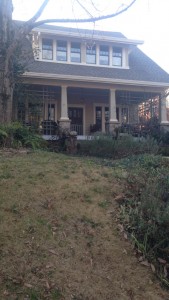This is a common type of home one would see while passing through Virginia Highlands. Before visiting my site, the research I did for my annotated bibliographies led me to discover that this type of home is known as a Craftsman Bungalow. This style of home was first introduced by a man named Gustave Stickley. Craftsman Bungalows have been present in Virginia Highlands since the neighborhood was first built. As I walked up and down the streets of the area I found these homes to be very inviting. Most are painted pleasant, light colors. It gives the space a homey and suburban feel.
Tag: Craftsman Bungalow
Annotated Bibliographies 1,2, and 3
This website reports on all things Virginia-Highland. Everything from volunteer opportunities to the preservation and history of the area are easily accessible from this webpage. The information I obtained furthered my knowledge of the area greatly. Scans of some of the original historic maps of Virginia Highlands, some as early as 1871, show how the area has transformed over time. The maps show the slow but steady increase in industrialization and development of the area, thus showing in detail how the built environment was formed. The site lists all the parks, which is important in shaping the area’s built environment, and where they are located. This site provides an array of information and is kept by the Virginia-Highland Civic Association, making it a reliable and useful source. Although this association provides more information on the area than any other site, the source could possibly be biased. Because the association only considers one view, details about the area’s history and current status may be left out. Overall, this source provides a bulk of information to further the viewer’s knowledge about Virginia-Highlands and built environment within the area’s borders.
Annotated Bibliography #2
The short film goes deep into the history of Virginia-Highlands, going back to the first settlers of the area, which were Creek Indians. The community was agrarian based, but most of that was ruined after the Civil War. Most families had to rebuild their lives, due to the many battles fought during the war. As the town was rebuilt, trolley lines were built, which connected Virginia-Highlands to other surrounding Atlanta burrows and made travel more accessible. This video mentions multiple pieces of important information about the built environment that cannot easily be found on the webpage. This source is very informative and addresses several different controversial events that the webpage does not, such as the land lottery only offering land to free white males and the different opinions about the widening of I-485. The widening of the highway was controversial because it would have obliterated parks and hundreds of homes. Thus, citizens began taking a stand against it and formed the Virginia Civic Association to combat the highway widening. This short film provides a lot of vital information about the architecture and development of Virginia-Highlands and furthered my understanding of how the area came to be what it is today.
This encyclopedia article provides insight to how architecture in Virginia-Highlands was created and where the inspiration was drawn from. Gustav Stickley and his magazine, The Craftsman, inspired the Craftsmen bungalow. This style of home, which still fills the streets of Virginia-Highlands today, incorporates exposed wood, front porch columns, and shingle siding. Craig mentions how this type of architecture symbolizes freedom and character, which are popular democratic morals for Americans. More specific information on where the inspiration for the built environment came from is found in this article, whereas the short film and webpage do not do so. This article provides direct evidence on how and why the homes in Virginia-Highlands look the way they do. This source varies from the others in that it focuses mostly on architecture rather than historical and present events in the area.

